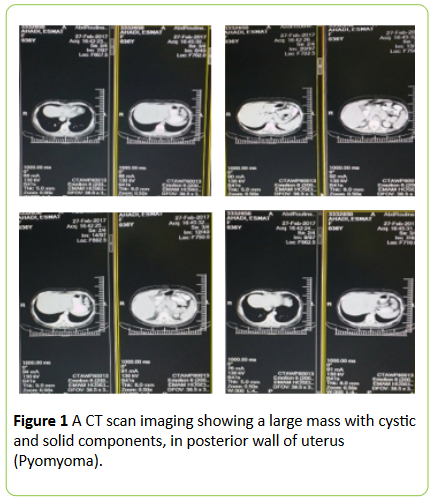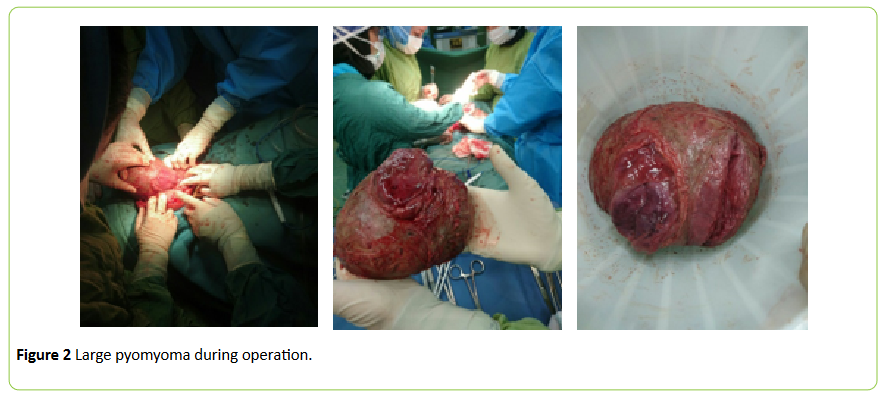Pyomyoma as a Rare Source of Post-Abortal Sepsis: A Case Report
Maasoumeh Mirzamoradi, Maasoumeh Saleh, Elham Pournajaf and Samaneh Esmaeili
DOI10.21767/2471-8041.100073
Maasoumeh Mirzamoradi, Maasoumeh Saleh*, Elham Pournajaf and Samaneh Esmaeili
Department of Gynecology and Obstetrics, Mahdiyeh Hospital, Shahid Beheshti University of Medical Sciences, Tehran, Iran
- *Corresponding Author:
- Maasoumeh Saleh
Department of Gynecology and Obstetrics
Mahdiyeh Hospital, Shahid Beheshti
University of Medical Sciences, Tehran, Iran
Tel: +98-21-22021000/+98-917-3210783
E-mail: salehmaasoumeh@yahoo.com
Received Date: June 20, 2017 Accepted Date: July 26, 2017 Published Date: July 28, 2017
Citation: Mirzamoradi M, Saleh M, Pournajaf E, et al. (2017) Pyomyoma as a Rare Source of Post-Abortal Sepsis: A Case Report. Med Case Rep. Vol .3 No.3:38 doi: 10.21767/2471-8041.100063
Abstract
We report the successful treatment of post-abortal pyomyoma, a rare but serious complication of uterine leiomyomata in a 36-year-old woman. She was known to have a sub-mucosal to intramural leiomyoma. She was presented with abdominal pain and fever after miscarriage two weeks later. Pelvic CT-Scan showed a postpartum pyomyoma that was initially managed with intravenous antibiotics to avoid surgery but due to persistent sepsis, she required laparotomy and myomectomy. She had good recovery after operation.
Keywords
Pyomyoma; Post-abortal sepsis; Leiomyoma
Introduction
Uterine leiomyomas are the most common neoplasms of the uterus. Many women who have fibroids do not have any symptoms. Pyomyoma is a pyogenous infection of a leiomyoma and occurs when a leiomyoma undergoes infarction and subsequent infection. It is a rare, yet potentially fatal complication of uterine leiomyoma. It is more usual in pregnant women and postmenopausal women who have vascular disease [1,2]. The possible routs of infection for the development of pyomyoma have been described as contiguous spread from the endometrial cavity, direct extension from the adjacent bowel or adnexa, or haematogenous or lymphatic spread from infection elsewhere in the body [3,4]. Delayed diagnosis may result in serious complications, such as rupture into the abdominal or endometrial cavity, septicaemia, respiratory distress syndrome and even mortality [5,6]. In the vast majority of these cases, total abdominal hysterectomy is required to avoid severe morbidity and potential mortality [7]. Management during pregnancy is complicated by the desire to avoid hysterectomy and to preserve future fertility, particularly when the pyomyoma is associated with late miscarriage [8]. We present a case of pyomyoma after miscarriage who managed conservatively but due to persistent sepsis, myomectomy was done successfully with conservation of the uterus.
Case Report
The patient was a 36-year-old Iranian woman, 18 weeks of gestation, who presented with prolonged rupture of membrane. She did not have any history of medical disease. She had cesarean section 12 years ago and had history of secondary infertility who was candidate for myomectomy but she became pregnant in spontaneous conception. In physical examination, she had blood pressure: 110/70 mmHg, pulse rate: 90 beats per minute, temperature: 37°C and uterine height: 24 weeks. In vaginal examination, she had rupture of membrane and 2 centimeters dilatation of cervix. In her ultrasonography, in 12 weeks of gestation, she had 13 cm × 12 cm sub-mucosal to intramural myoma and a normal fetus. Her fetus passed spontaneously two hours after admission.
Due to incomplete passage of placenta, after injection of one dose cefazolin (1 g), curettage was done under guide of ultrasonography. After that, she received intravenous antibiotics (clindamycin and gentamycin) for 24 hours. She was discharged in good condition two days after curettage. Two weeks later, she presented with fever and lower abdominal pain. In physical examination, she had blood pressure: 110/70 mmHg, pulse rate: 110 beats per minute and temperature: 38.3°C.
She had tenderness on uterus and uterine height was 20 weeks. Ultrasonography showed a hetero-echoic mass (14 cm × 12 cm × 10 cm) in posterior side of uterus and endometrial thickness was 13 mm. With diagnosis of endometritis or infected myoma, she was admitted and received intravenous antibiotics (clindamycin and gentamycin). Her lab tests were: WBC: 17,000, Hgb: 10.8, Platelet: 690,000, ESR: 55, CRP: 20 and normal liver and kidney function tests. She presented with chills, tachycardia (pulse rate: 120 beats per minute) and fever (Temperature: 42°C), 12 hours after admission. Conservative management was planned for her. Antibiotics changed to broad spectrum types (meropenem and vancomycin). Pelvic CT-Scan showed a hyper-dense mass (12 cm × 15 cm) in pelvic cavity (infected degenerated myoma) (Figure 1). Due to persistent fever, she was candidate for myomectomy. Lab tests before operation was: WBC: 7,000, Hgb: 8, Platelet: 556,000. Two units of packed cell were transfused. During operation, she had infected degenerated myoma (20 cm × 20 cm) and myomectomy was done (Figure 2). Antibiotics continued after operation and 24 hours later, she was afebrile. She was discharged in good condition, 5 days after operation.
Discussion
Leiomyoma is a benign smooth muscle tumor. Complications of leiomyoma in pregnancy are spontaneous abortion, preterm premature rupture of membranes (PPROM), preterm labour, obstructed labour, postpartum haemorrhage and degeneration [9]. Pyomyoma, also called suppurative leiomyoma, is a bacterial infection that occurs inside the uterine myoma. It is a rare, but life-threatening condition that may occur in post-menopausal women, during pregnancy and in the postpartum period. The risk of suppurative complications of myoma is increased by pregnancy. Pyomyoma is usually associated with polymicrobial infection [4]. The possible routs of infection for the development of pyomyoma have been described as contiguous spread from the endometrial cavity, direct extension from the adjacent bowel or adnexa, or haematogenous or lymphatic spread from infection elsewhere in the body [3,4]. In our case, it is possible that bacterial seeding of the fibroid may have begun as a result of PPROM and ascending infection.
Abdominal pain was reported in some cases, but fever was generally the only symptom, especially in the early stages [10]. This case presented with fever and abdominal pain. Pyomyoma should be considered in the broad differential diagnosis of postpartum fever, especially if concomitant with bacteraemia and uterine fibroids but no other obvious source of infection. Pyomyoma is critical because the mortality rates approach 21-30% [4]. Delayed diagnosis may result in serious complications, such as rupture into the abdominal or endometrial cavity, septicaemia, respiratory distress syndrome and even mortality [5,6] The differential diagnosis of pyomyoma is extensive and includes pyometra, tubo-ovarian abscess or malignancy [11]. In pregnant women, septic abortion and red generation of fibroid should be suspected first.
Sonographic findings of pyomyoma include an enlarging pelvic mass with solid or cystic component. The presence of gas in leiomyoma is diagnostic of pyomyoma. CT scan findings of pyomyoma would include heterogeneous density mass with a solid and cystic component and the presence of gas and debris [12]. CT scan is more useful. Our patient was investigated with ultrasound and CT scan. In our case, CT scan showed a large hyper-dense mass with solid and cystic components.
The definite treatment of uterine pyomyoma consists of aggressive antibiotics and myomectomy or hysterectomy or CT-guided drainage. Drainage or myomectomy was performed instead of hysterectomy, if the woman was desirous of future fertility, as myomectomy in our case.
Conclusion
Pyomyoma is an unusual complication of leiomyoma. It is more common during pregnancy due to rapid growth of leiomyoma. Due to high rates of morbidity and mortality, early diagnosis is crucial. Fever may be only manifestation during the early stages, so different differential diagnosis may be considered during postpartum period. The diagnosis can be difficult. Triad of fever, leiomyoma and absence of other sources of fever is diagnostic. Ultrasound and CT scan can help diagnosis. Surgical treatment is often indicated.
References
- Sah SP, Rayamajhi AK, Bhadani PP (2005) Pyomyoma in a post-menopausal woman: A case report. Southest Asian J Trop Med Public Health 36: 979-981.
- Karcaaltincaba M, Sudakoff GS (2003) CT of a ruptured pyomyoma. Am J Roentgenol 181: 1375-1377.
- Mosan T, Adair J, Lee Y (2005) Postpartum pyomyoma. J Natl Med Assoc 97: 826-828.
- Greenspoon JS, Ault M, James BA, Kaplan L (1990) Pyomyoma associated with polymicrobial bacteremia and fatal septic shock: case report and review of the literature. Obstet Gynecol Surv 45: 563-569.
- Genta Pedro R, Dias ML, Janiszewski TA, Carvalho JP, Aria MH, et al. (2001) Stereptococcus agalactine endocarditis and giant pyomyoma simulating ovarian cancer. South Med J 94: 508-511.
- Zangeneh M, Mahdavi AA, Amini E, Siadat SD, Karimian L (2010) Pyomyoma in premenopausal woman with fever of unknown origin. Obstet Gynecol 116: 526-528.
- Demaio A, Doyle M (2015) Pyomyoma as a rare source of post-partum sepsis. Case Reports in Obstetrics and Gynecology.
- Mandeep K, Rath G, Joseph I, Anna LD (2015) Postpartum pyomyoma, A rare complication of sepsis associated with chorioamnionitis and massive postpartum haemorrhage treated with an intrauterine ballon. Case Reports in Obstetrics and Gynecology.
- Coronado GD, Marshall LM, Schwartz SM (2000) Complications in pregnancy, labour and delivery with uterine leiomyomas: a population-based study. Obstet Gynecol 95: 764-769.
- Cosmo DB, Francesco M, Valeria B, Francesco M, Angelo V, et al. (2013) Postpartum fever in the presence of a fibroid: Sphingomonas paucimobilis sepsis associated with pyomyoma. BMC Infectious Diseases 13: 574.
- Avantika G, Madhavi MG, Usha M (2014) Ascending infection causing pyoma in a young woman. The Egyptian Journal of Radiology and Nuclear Medicine 45: 1017-1020.
- Mubarak MY, Noordini MD (2008) A case report of pyomyoma: radiological diagnosis of a potentially fatal complication of uterine leiomyoma. The International Medical Journal 7: 63-65.

Open Access Journals
- Aquaculture & Veterinary Science
- Chemistry & Chemical Sciences
- Clinical Sciences
- Engineering
- General Science
- Genetics & Molecular Biology
- Health Care & Nursing
- Immunology & Microbiology
- Materials Science
- Mathematics & Physics
- Medical Sciences
- Neurology & Psychiatry
- Oncology & Cancer Science
- Pharmaceutical Sciences


